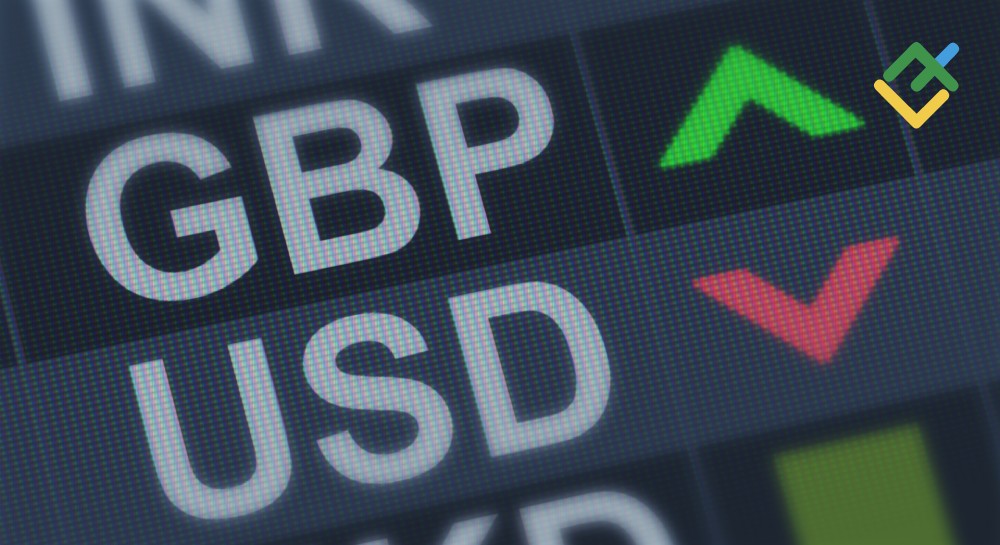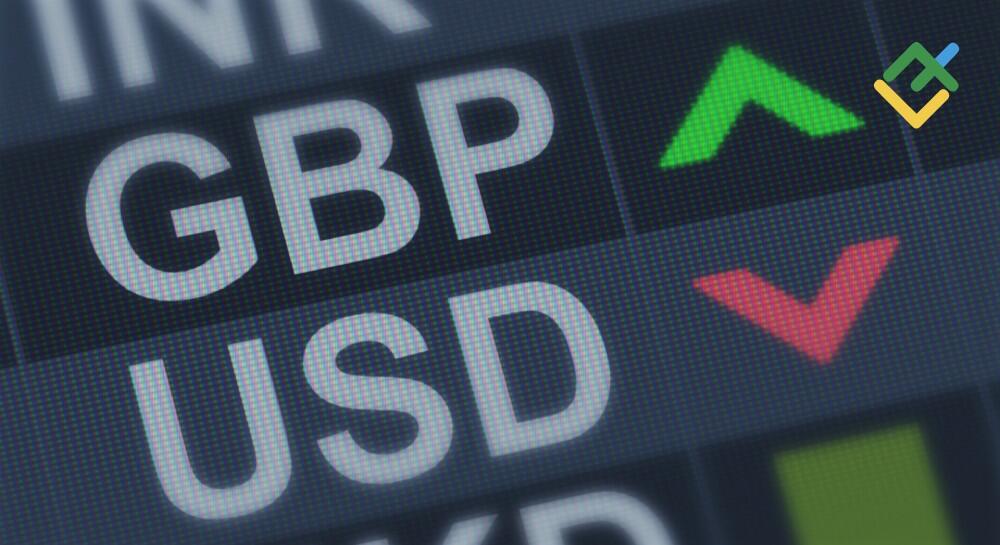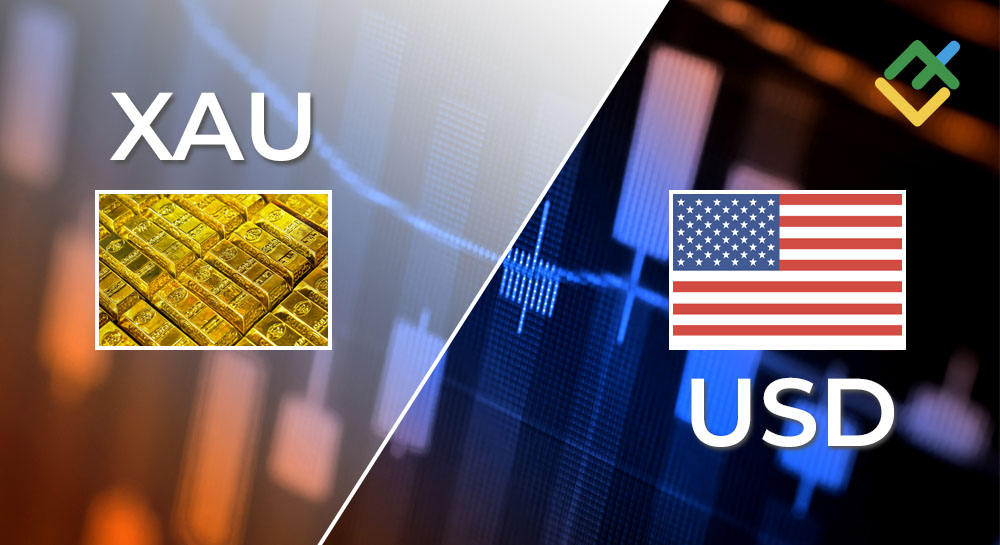
The GBP/USD pair is one of the most popular major currency pairs in the Forex market, representing the exchange rate of the British pound against the US dollar. This pair is highly sought after by traders, investors, and hedge fund managers globally.
This article reviews the history and features of the trading instrument, providing technical and fundamental analysis and examining long-term forecasts from reputable analytical agencies. The analysis provides insights into the factors influencing the GBPUSD rate, optimal timing for transactions, and the potential value of adding the currency pair to your trading portfolio.
The article covers the following subjects:
Major Takeaways
- The current price of the GBPUSD pair is $1.28933 as of 26.03.2025.
- The GBPUSD pair reached its all-time high of $2.4546 on 04.11.1980. The pair’s all-time low of $1.052 was recorded on 26.02.1985.
- The GBP/USD is one of the major currency pairs and is distinguished by its high liquidity and volatility.
- The GBPUSD rate is shaped by both UK and US economic indicators, interest rates of central banks, and political events.
- The currency pair demonstrates notable trading activity during the European and US trading sessions, coinciding with market hours in London and New York.
- The GBPUSD pair exhibits a negative correlation with the USDCHF pair and a positive correlation with the EURUSD pair.
GBPUSD Real-Time Market Status
The GBPUSD currency pair is trading at $1.28933 as of 26.03.2025.
When analyzing the GBPUSD pair, it is essential to closely monitor the interest rate decisions made by the Bank of England and the US Federal Reserve, along with key economic indicators such as UK and US inflation rates, and employment data. Historical lows and highs can be used to identify key support and resistance levels. Meanwhile, technical analysis can help identify optimal entry and exit points, enhancing the effectiveness of your trading strategies.
|
Metric |
Value |
|
Bank of England interest rate |
4.5% |
|
US Federal Reserve interest rate |
4.5% |
|
UK inflation rate |
3.0% |
|
US inflation rate |
2.7% (Fed forecast) |
|
All-time low |
$1.052 |
|
All-time high |
$2.4546 |
|
Price change over the last 12 months |
+2.45% |
GBPUSD Price Forecast for 2025 Based on Technical Analysis
On the W1 chart, the GBPUSD pair is maintaining a sustainable upward trend. The price has pierced and settled above the SMA 50 and SMA 20.
On the D1 chart, the pair is displaying a bullish trend. The price is trading above the 50-day and 200-day simple moving averages. At the same time, the SMA 50 is trending upward below the price, reinforcing bullish sentiment. However, the upward momentum has slowed near the 1.3000 level, suggesting a looming correction or consolidation.
Key support and resistance levels:
Resistance levels: 1.3000; 1.3222; 1.3440.
Support levels: 1.2800; 1.2760; 1.2650; 1.2548.
Technical indicators:
-
Fibonacci levels (D1): key correction levels are 38.2% (1.2835) and 50% (1.2777).
-
MACD: the indicator points to a bullish trend on W1, while the uptrend is fading on D1, suggesting that a downward reversal is possible.
-
Stochastic and RSI: an overbought condition on both time frames increases the probability of a decline.
On the daily chart, the pair has formed a swing high within an ascending channel. On the weekly chart, a candlestick with a long upward shadow has emerged, implying that bullish sentiment may have intensified. In the short term, the pair may face a correction to 1.2800–1.2770. If the quotes manage to remain above 1.2650, they will likely surge to 1.3100–1.3300. In this case, the price is expected to increase gradually.
The following table presents the lowest and highest values of the GBPUSD rate until the end of 2025.
|
Month |
Minimum, $ |
Maximum, $ |
|
April |
1.275 |
1.295 |
|
May |
1.270 |
1.292 |
|
June |
1.265 |
1.288 |
|
July |
1.270 |
1.300 |
|
August |
1.278 |
1.310 |
|
September |
1.283 |
1.318 |
|
October |
1.301 |
1.325 |
|
November |
1.288 |
1.313 |
|
December |
1.275 |
1.310 |
Long-Term Trading Plan for GBPUSD
The GBPUSD pair continues to trade within an ascending channel, with a recent slowdown in growth near the 1.3000 level. The prevailing scenario suggests a correction from the current values towards 1.2835 and 1.2770. These levels coincide with the channel boundaries and the Fibonacci retracement. In the event of a reversal, short positions from the area of 1.2980–1.3000 can be considered, with a stop-loss order set above the 1.3050 level.
If the pair decreases to a strong support level of 1.2770, it will likely embark on an upward trajectory and climb to 1.2950–1.3000.
The outlook for the coming weeks is moderately bearish. A decline to 1.2800 is anticipated. If the correction intensifies, the price may slide to 1.2650.
In the second half of the year, if the price remains above 1.2650, a gradual recovery to 1.3100–1.3300 is projected.
Against this backdrop, one may consider opening trades within the ascending channel, taking into account the signals generated by the technical indicators.
Analysts’ GBPUSD Price Projections for 2025
Analysts offer varying forecasts for the GBPUSD rate in 2025, ranging from moderate growth to a smooth correction.
LongForecast
Price range in 2025: $1.194–$1.345 (as of 22.03.2025).
According to LongForecast, the GBP/USD pair is projected to show moderate volatility in 2025. The price will likely display smooth fluctuations with a slight increase by the year-end.
|
Month |
Average, $ |
Minimum, $ |
Maximum, $ |
|
April |
1.304 |
1.263 |
1.345 |
|
May |
1.301 |
1.281 |
1.321 |
|
June |
1.288 |
1.269 |
1.307 |
|
July |
1.267 |
1.246 |
1.288 |
|
August |
1.249 |
1.230 |
1.268 |
|
September |
1.222 |
1.194 |
1.249 |
|
October |
1.233 |
1.212 |
1.254 |
|
November |
1.258 |
1.235 |
1.280 |
|
December |
1.281 |
1.261 |
1.300 |
WalletInvestor
Price range in 2025: $1.279–$1.316 (as of 22.03.2025).
WalletInvestor assumes that the pair will trade within a narrow range, with no sharp fluctuations. By July, the rate will stand near $1.310. By December, it will likely decline to $1.279.
|
Month |
Average, $ |
Minimum, $ |
Maximum, $ |
|
April |
1.303 |
1.296 |
1.310 |
|
May |
1.306 |
1.302 |
1.310 |
|
June |
1.307 |
1.306 |
1.313 |
|
July |
1.310 |
1.304 |
1.316 |
|
August |
1.308 |
1.300 |
1.315 |
|
September |
1.298 |
1.294 |
1.302 |
|
October |
1.292 |
1.290 |
1.294 |
|
November |
1.288 |
1.285 |
1.292 |
|
December |
1.284 |
1.279 |
1.291 |
CoinCodex
Price range in 2025: $1.279496–$1.449187 (as of 22.03.2025).
CoinCodex expects the GBP/USD pair to fluctuate widely in 2025. The price may rise to $1.449187.
|
Month |
Minimum, $ |
Average, $ |
Maximum, $ |
|
April |
1.279496 |
1.317266 |
1.345983 |
|
May |
1.322379 |
1.348820 |
1.366274 |
|
June |
1.355359 |
1.390379 |
1.404116 |
|
July |
1.351067 |
1.375824 |
1.400744 |
|
August |
1.366287 |
1.393725 |
1.411639 |
|
September |
1.400361 |
1.436819 |
1.449187 |
|
October |
1.392383 |
1.408840 |
1.435282 |
|
November |
1.352046 |
1.376554 |
1.407171 |
|
December |
1.342240 |
1.364844 |
1.379806 |
Analysts’ GBPUSD Price Projections for 2026
Experts are divided in their predictions for the GBPUSD in 2026. Some experts anticipate a gradual strengthening of the pound, while others foresee persistent uncertainty and high volatility.
LongForecast
Price range in 2026: $1.242–$1.341 (as of 22.03.2025).
LongForecast suggests that the GBP/USD pair is expected to maintain a moderate uptrend in 2026. Growth with seasonal corrections is predicted.
|
Year |
Minimum, $ |
Average, $ |
Maximum, $ |
|
2026 |
1.242 |
1.283 |
1.341 |
WalletInvestor
Price range in 2026: $1.258–$1.295 (as of 22.03.2025).
According to WalletInvestor, the pair will move within a narrow sideways channel in 2026, without significant swings, indicating low volatility compared to the previous year.
|
Year |
Minimum, $ |
Average, $ |
Maximum, $ |
|
2026 |
1.258 |
1.277 |
1.295 |
CoinCodex
Price range in 2026: $1.310655–$1.481893 (as of 22.03.2025).
CoinCodex assumes that the British pound will steadily rise in 2026. GBPUSD quotes may reach 1.48.
|
Year |
Minimum, $ |
Average, $ |
Maximum, $ |
|
2026 |
1.310655 |
1.400248 |
1.481893 |
Analysts’ GBPUSD Price Projections for 2027
In 2027, analysts expect the GBPUSD pair to demonstrate mixed trading. Some experts are optimistic about the British pound, while others foresee a decline in the UK currency.
LongForecast
Price range in 2027: $1.275–$1.439 (as of 22.03.2025).
LongForecast anticipates a significant strengthening of the British pound during 2027. The maximum price is expected at $1.439 in September.
|
Year |
Minimum, $ |
Average, $ |
Maximum, $ |
|
2027 |
1.237 |
1.332 |
1.439 |
WalletInvestor
Price range in 2027: $1.237–$1.274 (as of 22.03.2025).
WalletInvestor projects that the GBPUSD pair will gradually decline to $1.237 in 2027. At the same time, volatility is expected to remain low.
|
Year |
Minimum, $ |
Average, $ |
Maximum, $ |
|
2027 |
1.237 |
1.259 |
1.274 |
CoinCodex
Price range in 2027: $1.131185–$1.384192 (as of 22.03.2025).
According to Coincodex, the pair will grow at the beginning of the year. However, in the second half of the year, growth will be followed by a decline.
|
Year |
Minimum, $ |
Average, $ |
Maximum, $ |
|
2027 |
1.131185 |
1.271313 |
1.384192 |
Analysts’ GBPUSD Price Projections for 2028
In 2028, the GBPUSD pair may experience a period of heightened uncertainty. Analytical platforms offer different projections. While some anticipate robust growth, others expect a persistent downward trend.
LongForecast
Price range in 2028: $1.182–$1.334 (as of 22.03.2025).
LongForecast assumes that the British pound will weaken in 2028. In December, the price will slide to the level of $1.200.
|
Year |
Minimum, $ |
Average, $ |
Maximum, $ |
|
2028 |
1.182 |
1.248 |
1.334 |
WalletInvestor
Price range in 2028: $1.216–$1.253 (as of 22.03.2025).
WalletInvestor suggests that the pair will trade in a narrow range in 2028. The forecast offers a neutral outlook, and the general direction is close to flat with minor monthly fluctuations.
|
Year |
Minimum, $ |
Average, $ |
Maximum, $ |
|
2028 |
1.216 |
1.238 |
1.253 |
CoinCodex
Price range in 2028: $1.121301–$1.265979 (as of 22.03.2025).
CoinCodex analysts believe that the pound will recover in 2028. A smooth uptrend is expected. The price may rise to 1.265979.
|
Year |
Minimum, $ |
Average, $ |
Maximum, $ |
|
2028 |
1.121301 |
1.208711 |
1.265979 |
Analysts’ GBPUSD Price Projections for 2029
Forecasts for 2029 reflect different scenarios. Some projections assume that the GBPUSD pair may correct, while others anticipate the pair to recover. Let’s examine the estimates of LongForecast, WalletInvestor, and CoinCodex below.
LongForecast
Price range in 2029: $1.150–$1.222 (as of 22.03.2025).
LongForecast predicts a downtrend for the GBPUSD pair in 2029. The pair will likely fall from $1.200 to $1.191 by April. The US dollar is expected to strengthen against the British pound.
|
Year |
Minimum, $ |
Average, $ |
Maximum, $ |
|
2029 |
1.150 |
1.194 |
1.222 |
Walletinvestor
Price range in 2029: $1.195–$1.232 (as of 22.03.2025).
WalletInvestor expects the GBPUSD pair to trade in a narrow sideways range. Insignificant monthly fluctuations indicate low volatility and the absence of a pronounced trend during 2029.
|
Year |
Minimum, $ |
Average, $ |
Maximum, $ |
|
2029 |
1.195 |
1.218 |
1.232 |
CoinCodex
Price range in 2029: $1.180721–$1.336942 (as of 22.03.2025).
CoinCodex suggests that the British pound will recover in the second half of 2029. The GBPUSD pair could reach 1.336942.
|
Year |
Minimum, $ |
Average, $ |
Maximum, $ |
|
2029 |
1.165061 |
1.250184 |
1.336942 |
Analysts’ GBPUSD Price Projections for 2030
Forecasts for 2030 also differ. Some experts anticipate a decline, while others expect moderate growth.
CoinCodex
Price range in 2030: $1.118498–$1.255147 (as of 22.03.2025).
According to Coincodex, GBPUSD quotes may display gradual growth in 2030. The average price during the year may exceed $1.182, and under favorable conditions, it may reach a high of $1.255.
|
Year |
Minimum, $ |
Average, $ |
Maximum, $ |
|
2030 |
1.118498 |
1.182936 |
1.255147 |
TradersUnion
Price range in 2030: $1.1492–$1.1610 (as of 22.03.2025).
TradersUnion analysts expect a decline in GBPUSD quotes in 2030. By December, the pound will likely weaken and fall to $1.1492 against the greenback.
|
Year |
Mid-Year, $ |
Year-End, $ |
|
2030 |
1.1610 |
1.1492 |
Analysts’ GBPUSD Price Projections Until 2050
The GBPUSD exchange rate outlook for the next three decades is marked by a significant degree of uncertainty. Major economic and geopolitical shifts, including reforms, crises, and changes in monetary policy, may occur over the course of the next several years.
The adoption of digital currencies, demographic shifts, and technological breakthroughs also have the potential to impact the market dramatically. In light of these uncertainties, it is essential to emphasize that long-term forecasts are merely indicative and should not be used as a basis for decision-making.
Short- and medium-term estimates that consider current market trends, interest rates, inflation, and the macroeconomic landscape are more reliable tools for making investment decisions.
Market Sentiment for GBPUSD on Social Media
Social media sentiment reflects opinions about an asset on social media platforms and can influence investors’ decisions. For example, news on UK GDP growth improves market sentiment, increasing demand for the GBP. On the other hand, negative sentiment often triggers sell-offs. Analyzing news, social media, and expert reviews helps investors assess the prevailing sentiment – whether it is bullish, bearish, or neutral – and adjust their strategies if needed.
Let’s take a look at some posts on the X platform.
@goddessngozi expects the GBPUSD pair to continue to rise from the 1.28845 level with a target of 1.30139. The chart shows that an upward reversal is looming.
User @trader_minato also expects the GBPUSD pair to increase. The user notes that the pair is trading within a robust uptrend and suggests opening long positions on the lower time frames. The author of the post points out the fair value gap (FVG) – an area just below the current price, where it is possible to open positions.
Trader @_guypiccolo forecasts the GBP/USD rate to decline, suggesting that the price has reached the HTF supply zone and is poised to decline. The chart shows the expected downward movement after rebounding from the resistance level.
Traders have different opinions about the future direction of the GBPUSD pair. Some are bullish and expect the pair to continue to rise from key levels, while others expect the pair to fall. As a result, the GBPUSD market is likely to face uncertainty and be highly sensitive to technical levels.
GBPUSD Price History
The GBPUSD pair reached its all-time high of $2.4546 on 04.11.1980.
The lowest price of the GBPUSD pair was recorded on 26.02.1985 and reached $1.052.
Below is a chart showing the GBPUSD pair’s performance over the last ten years. In this connection, it is important to evaluate historical data to make predictions as accurate as possible.
The GBP/USD pair has experienced substantial changes over the past two decades due to various economic and political events.
Between 2007 and 2009, the pair experienced notable volatility. During the global financial crisis, the British pound dropped from 2.00 to 1.40, reflecting a decline in investor confidence in the UK economy.
In 2016, the GBPUSD rate fluctuated due to external market factors. The referendum on the UK’s withdrawal from the EU (Brexit) in June 2016 led to a sharp decline in GBPUSD quotes from 1.50 to 1.32 and then to 1.20 in October 2016.
In 2020, the GBPUSD pair fluctuated due to the global pandemic. The pair saw significant market volatility, with the value of the pound falling to 1.15 in March but then recovering to 1.35 by the end of the year due to stimulus measures.
In September of 2022, GBPUSD quotes slid to 1.07, reflecting a market reaction to the announcement of a major tax cut in the UK.
In 2024, the pound strengthened and reached 1.33 in September due to the Bank of England’s decision to keep interest rates unchanged amid declining inflation.
These fluctuations underscore the sensitivity of the GBPUSD rate to global economic developments, domestic policies, and market sentiment.
GBPUSD Price Fundamental Analysis
The GBPUSD pair is sensitive to shifts in the UK and US economies. Analyzing these factors helps to determine long-term trends and predict possible fluctuations in the exchange rate.
What Factors Affect the GBPUSD Pair?
The GBP/USD rate is influenced by the following fundamental factors:
- Interest rate differential between the Bank of England and the US Federal Reserve.
- Inflation and unemployment rate.
- Economic growth rate (GDP).
- Political stability and statements of officials.
- Export/import volumes and trade balance.
- Labor market and the level of consumer spending.
- Geopolitical risks and global crises.
- Investor expectations and financial market sentiment.
More Facts About GBPUSD
The pound sterling (GBP) is one of the world’s oldest currencies. It appeared back in the 8th century in Anglo-Saxon England as a monetary unit equal to the weight of a pound of silver. Over time, the currency became the backbone of trade and finance of the British Empire, and today it is one of the key reserve currencies, playing a key role in international trade and investment.
The GBP/USD pair is one of the most liquid and actively traded currency pairs on Forex, reflecting the relative strength of the UK and US economies. Widely used by traders and investors for speculation, hedging, and diversification, its high liquidity and narrow spreads emphasize its importance in the global financial markets.
Advantages and Disadvantages of Investing in GBPUSD
The GBP/USD pair is quite popular on Forex due to its high liquidity. However, like any trading asset, it has its pros and cons, which are important to consider when making trading decisions.
Advantages
- High liquidity and narrow spreads on Forex.
- Wide availability for traders worldwide.
- Long history and predictability of price movements.
- Responds promptly to macroeconomic data and news.
- Suitable for both short-term and long-term trading.
- Backed by major banks and institutional investors.
- Often used in arbitrage strategies and hedging.
- Wide range of analytical and technical tools.
Disadvantages
- Increased sensitivity to political events in the UK and the US.
- May face high volatility when economic statistics are released.
- May require deep fundamental analysis for more accurate forecasts.
- Exposure to statements by the Bank of England or Fed officials.
- Price gaps and spikes during market uncertainty.
- Dependence on global risk and risk appetite.
- Requires active position control in short-term trading.
- May entail losses when trading with high leverage.
The GBPUSD currency pair is a prominent instrument in the foreign exchange market, characterized by high liquidity, accessibility, and extensive exposure to analysis. However, it is crucial for investors to acknowledge inherent risks, including elevated volatility, geopolitical shifts, and the impact of unexpected macroeconomic events. When approached with a balanced strategy, the GBPUSD pair can become a reliable component of a diversified investment portfolio.
How We Make Forecasts
The forecasts are based on a combination of technical and fundamental analysis.
For estimates with a time horizon of several days to a week, the application of technical analysis is predominant. Price patterns, support and resistance levels, MACD, the RSI, and moving average indicators are employed. In addition, price behavior on different time frames is assessed.
Medium-term forecasts for 1–3 months rely on macroeconomic indicators, interest rates, inflation, and central bank decisions.
Long-term forecasts extending over a period of 6–24 months are informed by economic cycles, geopolitical factors, and global market trends. The seasonal patterns, historical levels, and the perspectives of reputable investment funds are integral to the refinement of these forecasts. Such a comprehensive approach enables us to assess the current price movement and the future trajectory of the analyzed currency pair.
Conclusion: Is GBPUSD a Good Investment?
The GBPUSD is a major currency pair in the Forex market, demonstrating notable sensitivity to economic developments in the UK and the US, a factor that makes it appealing for speculative trading.
Its appeal stems from its stability, high volatility, and exposure to a wide range of analytical tools. However, this pair is also driven by geopolitical factors, requiring constant monitoring. With proper risk management, the GBPUSD pair can become a valuable asset for diversifying an investment portfolio.
GBPUSD Price Prediction FAQs
The current price of the GBPUSD pair is $1.28933 as of 26.03.2025.
In the short term, the pair is expected to undergo a correction after testing the level of 1.30. In the medium term, growth is possible if the pound remains above 1.26. It will depend on market conditions and macroeconomic factors.
The forecast is moderately optimistic. The pair will likely range between $1.19 and 1.44. The main scenario assumes a moderate strengthening of the pound with stabilization of economic indicators and reduced volatility in other markets.
According to LongForecast, the exchange rate will range between $1.2430 and $1.3860 in 2026. WalletInvestor and CoinCodex also expect a gradual strengthening of the pound, provided the UK economy grows moderately.
CoinCodex expects a surge to $1.2551 with an average price of $1.1829. TradersUnion forecasts a decline to $1.1492. Forecasts vary, but both indicate muted trading without a pronounced trend.
Long positions can be considered on a pullback to the support area of $1.2650–$1.2750 if accompanied by reliable signals from technical indicators. Similarly, a promising buying opportunity emerges after a consolidation above $1.30, as the price may rise to $1.32–$1.33.
In March 2025, the pair exceeded $1.30, indicating a short-term strengthening of GBP. However, the oscillators point to an overbought condition, so a correction to support levels is likely looming.
For example, when the quotes are near swing lows in the area of $1.26–$1.27. This area offers favorable entry points into long positions.
Price chart of GBPUSD in real time mode
The content of this article reflects the author’s opinion and does not necessarily reflect the official position of LiteFinance broker. The material published on this page is provided for informational purposes only and should not be considered as the provision of investment advice for the purposes of Directive 2014/65/EU.
According to copyright law, this article is considered intellectual property, which includes a prohibition on copying and distributing it without consent.
{{value}} ( {{count}} {{title}} )
This post is originally published on LITEFINANCE.









